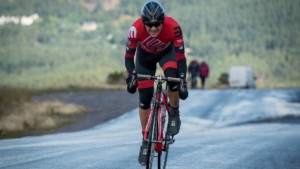When you hear the phrase endurance training you probably think of the pros going out on 6-hour long rides with their teammates. To you, instead of 6 hours in the saddle, it might be 2 hours in the cold and wind of the late winter. You're probably plodding along at zone 2. The goal is just “putting in miles” and preparing for your interval work that's scheduled a month from now.
I'm here to tell you there's a better way. There's a way that will net you bigger gains in the same amount of time. You don't need traditional base training. All you need to do is a little extra planning.
In this episode of the Tailwind Coaching Podcast, I'll show you how to use endurance training effectively. When you implement these five tips, your base training will never be easier or more effective.
Click through the jump to listen and learn how to turn your base training into an endurance masterpiece.
Podcast: Play in new window | Download (Duration: 39:36 — 29.0MB)
Subscribe: RSS
Endurance training is the perfect compliment to strength training
If your base training program involves a strength training component, endurance training is the perfect foil to it. There's a couple of reasons why that's the case:
 Endurance training is less physiologically demanding
Endurance training is less physiologically demanding
Endurance training is easier on the body, with less training stress applied during a workout. For the same amount of time, you can actually cut the training stress in half compared to a high-intensity type of workout. Remember that training stress is training stress, and stress is stress. The higher the stress levels on your body, the harder it will be for your body to recover following training and the slower your gains will happen.
Because endurance training is less physiologically demanding, your on-bike training won't suffer after a strength workout. In many cases, people find strength training and cycling to be difficult to mesh together. Lifting heavy one day can lead to residual fatigue the next day. That fatigue means your higher intensity training suffers because you're already tired out. By switching it up so your strength training is followed by easier, endurance based work, you can execute an effective strength workout and an efficient on-bike workout with less recovery time between them.
You use different energy systems for strength and endurance training
In very simple terms, your body uses a couple of different energy systems depending on the intensity and type of the exercise you're doing. Higher intensity training generally relies on anaerobic mechanisms such as creatine phosphate and glycolysis. Lower intensity work generally relies on oxygen-dependent aerobic mechanisms such as electron transport for energy.
In the case of endurance training, your body will burn greater amounts of fat compared to strength training. Strength training, particularly higher intensity training, will be more carbohydrate dependent. Because of this difference, endurance training on the bike will be much easier to accomplish along with strength and conditioning during your base training because they don't compete for fuel.
What constitutes a good endurance training program?
Building an endurance training program isn't as simple as “ride a lot of miles.” Saddle time is indeed part of the equation, but you should be spending that time productively. Adding technique work to your program will improve your outcomes more than just going out and riding.
So when you build an endurance training program, consider adding the following:
Neuromuscular training and pedal stroke work
Pedal stroke work and neuromuscular training are perfect to layer with your endurance training. Because it's low impact, most pedal stroke work can be done during your endurance rides. Adding intervals like single leg drills, spinups, and superspin drills can greatly increase your coordination. That increase in coordination not only increases your efficiency but makes you outright faster too.
Since most neuromuscular efficiency work is endurance based, fill those “base miles” with conditioning. You'll get double the value in the same amount of time.
Position training on the bike
Endurance training time is the perfect chance to get used to new positions or new equipment. If you want to change your cockpit, saddle, pedals or any other component that modifies your fit, do it during your endurance blocks. You will feel better about your new position if you have longer to adapt to it. That means endurance miles are the place to adapt to your new position.
You need to use the endurance phase to get used to equipment changes because there's less stress on your body. Think about it for a minute. The more power you put through the pedals, the more stress you put on your joints and soft tissues. If your body isn't used to a new position, the increased stress of a high-intensity workout can lead to an injury and knock you off the bike quickly.
An endurance block is also the perfect time to work on flexibility and mobility. By combining your endurance training with a program like my Unbreakable Core Stability program, you can improve your aero position and stability on the bike substantially. Those easier endurance miles allow you to practice staying in the drops or in a time trial position longer. They are also more effective than high-intensity interval workouts for this as well. In fact, once you go back to those high-intensity interval sessions, you'll find it much easier to stay in that aero tuck during hard efforts.
 Building saddle time
Building saddle time
There's no secret that bigger goals require more saddle time to achieve. If you're planning on riding a 12-hour double century, you need to be able to be in the saddle for 12 hours. Training for a max of 6 hours in the saddle won't cut it. After that 6 hours, your body will start to break down. That's a sure way to miss your primary season goal. It's also a way to end up with a rough case of saddle sores.
Muscular Endurance
If you need to train your body to endure a long time in the saddle, what better time to do it than during the endurance phase. Not only will you build saddle time (as mentioned earlier) but you'll be able to work on muscular endurance training as well.
I've talked about muscular endurance training plenty of times in the past, but it's always worth repeating. Muscular endurance is simply your body's ability to resist fatigue. As you continue riding at a steady state, muscle fibers begin to fatigue. More fibers need to be recruited in order to maintain that power output, which contributes to aerobic decoupling. By training your muscle fibers to be fatigue resistant, you're able to ride longer without relying on additional muscle mass. That means you have more left in the tank for the end of a ride.
Muscular endurance is awesome to include in the base phase because it can be combined with tons of different intervals such as sweetspot training to double your bang for the bug.
And speaking of sweet spot training…
Sweetspot Training
Sweetspot training (also called SST) is basically your bread and butter endurance training. It is known as SST because it's that spot that gives your progressive gains while being heavily repeatable at the same time. It's located around 91% of your Functional Threshold Power and can be repeated for days on end without burning out your engine.
During the base training phase, you should make sure around 50% to 60% of your training consists of this intensity. Balance the rest between lower intensity aerobic work and higher intensity zone 5 work. This ensures you have a sufficient base built when it comes time to drill down into event specific training.
With these tips in mind, how are you going to change your base training this year? You’ve got the tools to build the biggest base you can, so get your season planned and start racking up those hours.
If you like what you heard today, don’t forget to rate the podcast on iTunes and share it with your friends!
